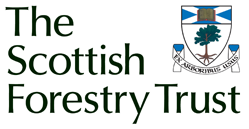Susceptibility of Scots and Lodgepole pine provenances to Red Band Needle Blight caused by Dothistroma septosporum
Carried out by: Aberdeen University; Forest Research
Summary Description:
This project began on 1st October 2011, when the student Stuart Fraser (BSc Sheffield; MSc Imperial) took up the position at the University of Aberdeen in collaboration with Forest Research. It is the first Trust supported project to receive support from The Scottish Forestry Trust-Forestry Commission Joint Bursary Award Scheme, and also received funding from Forest Enterprise Scotland and the Forestry Commission.
The study has 2 objectives
Objective 1. To determine the relative susceptibility of different host species to Dothistroma septosporum, (the causal agent of red band needle blight in Britain), with particular reference to different provenances of Scots and lodgepole pine.
Objective 2. To compare host resistance mechanisms between provenances and between species in response to inoculation with Dothistroma septosporum.
Timescale: 2011-2015
SFT Funds Awarded: £34,925
Project Outcomes:
Dothistroma needle blight (DNB), caused by the fungus D. septosporum, is the most important disease currently affecting British pine plantations. This project focused on inter- and intra-specific variation in DNB-susceptibility within pine species used in British forestry. Natural infection (NI) field experiments suggested that Pinus sylvestris (Scots pine) and Pinus contorta (lodgepole pine) had similar DNB-susceptibility, despite greater DNB impacts on P. contorta reported previously. In the same experiments, both P. sylvestris and P. contorta were less susceptible to DNB than Pinus muricata, Pinus nigra ssp. laricio (Corsican pine), Pinus nigra ssp. nigra and Pinus ponderosa. This pattern was not seen under controlled conditions in an artificial inoculation (AI) experiment. One explanation for the difference between results of AI and NI experiments, local (host) adaptation of D. septosporum isolates, was investigated. There was no support for any between-isolate variation in virulence on P. contorta and P. sylvestris, however.
Further AI experiments showed that between-population variation in DNB-susceptibility exists within native Scottish P. sylvestris. Between-population variation was not related to population relative continentality. NI experiments showed that P. sylvestris population relative susceptibility was not consistent between Scottish field sites or between years. Results from further AI and NI experiments produced no evidence for between-provenance differences in DNB-susceptibility within the wider P. sylvestris distribution. No simple relationship was found between P. sylvestris foliage volatile terpenoid abundance or composition and DNB-susceptibility.
No between-origin variation in DNB-susceptibility was observed in P. contorta in either AI or NI experiments, despite earlier reports from field surveys of the lower susceptibility of Alaskan P. contorta origins.
Areas for further research include the relative susceptibility of P. sylvestris and P. contorta (why did results of this project differ from those of previous surveys), the mechanisms behind the observed between-site variation in relative susceptibility of native Scottish P. sylvestris populations and intra-specific variation within P. contorta (explaining why results of this project differ from those from previous surveys).
SFT/FC Joint Bursary Award Scheme:. This project has received funding from the SFT/FC Joint Bursary Award.
In August 2015, Stuart Fraser won the Journal "Plant Pathology" student best paper competition for his article entitled "Intraspecific variation in susceptibility to dothistroma needle blight within native Scottish Pinus sylvestris". The article is referenced below.
Further Information
| Title | Source | Date |
|---|---|---|
| Intraspecific variation in susceptibility to dothistroma needle blight within native Scottish Pinus sylvestris S Fraser; A V Brown; S Woodward | Plant Pathology - Vol 64, issue 4, pages 864-870 | 2014 |
